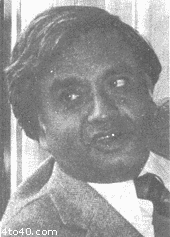 Govindjee — To re-live the area of discoveries in photosynthesis, a mock seminar was conducted at the University of Allahabad in 1952. Six young boys dressed in various European costumes, dirty gowns, old hats and baggy trousers, with powdered faces and thick moustaches, acted like the scientists who had made significant contributions to the understanding of photosynthesis.
Govindjee — To re-live the area of discoveries in photosynthesis, a mock seminar was conducted at the University of Allahabad in 1952. Six young boys dressed in various European costumes, dirty gowns, old hats and baggy trousers, with powdered faces and thick moustaches, acted like the scientists who had made significant contributions to the understanding of photosynthesis.
The role of Jan Ingenhouz, the eighteenth century physician who experimentally showed that photosynthesis takes place only in the present of light, was played by Govindjee, the organizer of the seminar. Like Ingenhouz, he argued that photosynthesis is vital to life on earth, that it gives oxygen to breathe and food to eat.
When the seminar concluded, there was much laughter and applause. The acting of the boys was praised. But no one present there must have thought that one day young Govindjee himself would make valuable contributions to the understanding of photosynthesis.
Govindjee is now Professor of Biophysics and Botany at the University of Illinois, USA. He was once introduced to the audience at a seminar held at Los Alamos Laboratory, New Mexico, thus: We depend upon photosynthesis and photosynthesis depends upon Govindjee.”
Photosynthesis is a process that takes place in green plants in sunlight. The green plants covert carbon dioxide from the air and water from the soil into oxygen and carbohydrates (molecules composed of carbon and hydrogen atoms). The plant releases oxygen and uses carbohydrates for its own growth.
The sites in plants where photosynthesis takes place are called “chloroplasts”. They contain a green pigment called chlorophyll. The pigment converts the incoming light energy from the sun into complex chemical compounds. The compounds further react with carbon dioxide and water in a complicated manner to produce oxygen and carbohydrates. The exact mechanism of this process is not yet known.
In collaboration with his students, Govindjee has been exploring the mechanism that enables plants to evolve oxygen and has been successful to a large extent. If man is able to understand photosynthesis fully, food production could be easily increased. There will no longer be hunger on earth.
Govindjee was born on October 24, 1933 in Allahabad, U.P. His father, Visheshwar Prasad, who was an educationist, did not believe in caste and creed and so dropped their family name of Asthana. Visheshwar Prasad died when Govindjee was hardly eleven. His mother was in poor health and so his elder brother, Krishnajee, brought him up. Krishnajee remembers that Govindjee was an inquisitive child, wanting to know the why and how of everything he saw. “Govindjee,” he says, “was fond of discussions to the extent that he disliked those who avoided discussion.”
Govindjee was interested in biology and physics from his school days. Fortunately, he had good teachers, one of whom introduced him to the wonders of nature. He used to watch the plants that grew in the little garden of his school for hours. Another teacher sharpened his interest in biology by explaining the subject in an exciting manner. Govindjee remembers he was good at learning from books but was always unsure of himself at practicals. Maybe this was the reason why he took up botany. He found cutting of plant sections easier than dissection of animals.
After taking his B.Sc. and M.Sc. from the University of Allahabad, standing first in the University in the latter, Govindjee left for the USA. in 1956.
 Kids Portal For Parents India Kids Network
Kids Portal For Parents India Kids Network






